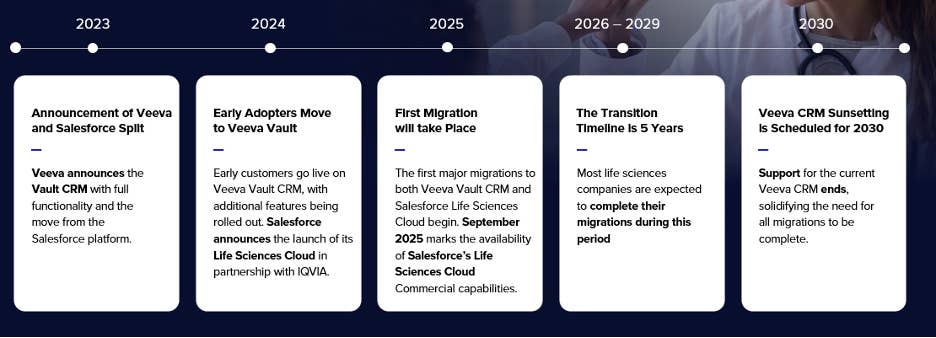By: Kent Groves, PhD, Global Head of Strategy, dentsu Health
Data is the lifeblood of healthcare marketing, and harnessing its power is no longer optional. Because of this, thousands of health and life sciences (HLS) businesses are rethinking their customer experience (CX) strategy to keep up with customer and organizational demands. But there’s a significant shift occurring that healthcare organizations need to be aware of: Veeva and Salesforce, long-time partners in providing CRM solutions tailored to healthcare brands, are parting ways, forcing organizations to reevaluate their data management strategies and CRM options.
The urgency to pick a platform is clear, but why exactly should this be priority one? The healthcare landscape is rich with metrics and insights that, when effectively aggregated and analyzed, can fuel optimized campaigns, personalized messaging, and ultimately, better patient outcomes. To achieve this, HLS brands need a robust platform that empowers them to harness their data and turn it into a strategic advantage.
Why the Veeva-Salesforce split matters
For years, several platforms and CRM systems providers have supported healthcare brands in capturing, measuring, and activating data for healthcare providers (HCP) and patient-level communications. Among these, Veeva (traditionally built on the Salesforce platform) and Adobe have stood out from the sea of vendors.
Here’s the critical and confusing decision: move to Veeva’s new Vault CRM, stay with Salesforce as they figure out a life sciences-tailored solution, or switch to something completely new like Adobe or IQVIA? The timeline below outlines the road ahead.

This separation, effective in 2025, marks a pivotal moment, requiring HLS brands to reassess their current data management and personalization strategies. Understanding where your organization stands in terms of data utilization and identifying the right CRM solution are crucial steps to ensure continued success. While this timeline doesn’t suggest that everything needs to be done this year, you do need to take action to evaluate, adopt and implement to start.
Let your CX strategy pave the way
With Veeva and Salesforce parting ways, it's crucial for healthcare organizations to understand the goals and future roadmap for their personalization efforts. Ultimately, your goals should align to the right CRM vendor that can help you power them.
Gather your stakeholders and review these considerations below:
1. Assess your current data management:
- Identify where your data is stored and how it is currently managed. Before potentially moving to another system, are there data siloes that need to be addressed?
- Ensure that your data is consistent, accurate, and complete. Also make sure you’re collecting the right data needed to activate on the experiences you want to provide.
2. Define what you need:
- Determine the level of integration required to combine data from different sources.
- Identify how you use data to personalize patient communications and treatment plans and define what use cases are must-haves for your strategy.
3. Explore each CRM option:
- Understand how each vendor collaborates and caters to your goals and needs.
- Request demos from each vendor you’re considering comparing each UX/UI.
Additionally, as you look to evaluate your timelines and business goals, you also have several decisions to make relative to how the platform decision should support your processes and CX strategy. This approach ensures that the chosen solution not only fits seamlessly into your existing workflows but also empowers you to deliver exceptional, personalized experiences to your customers, driving long-term loyalty and success.
These platforms play a crucial role in supporting HCP and patient-level communications by providing tools to aggregate and analyze data effectively.
The right tools power success
Once your organization has successfully organized its data and selected the right CRM solution, they unlock incredible opportunities to enhance patient care and operational efficiency. Here’s what you can expect:
- Personalized patient care:
Deliver more personalized treatment plans tailored to individual patient needs, improving patient outcomes and satisfaction.
- Enhanced patient engagement:
Engage patients more effectively through targeted communication strategies, ensuring they stay informed while building a stronger trusting connection with your brand. This approach helps HCPs build better rapport with their patients.
- Predictive analytics for proactive care:
Utilize advanced analytics to anticipate patient needs and even potential health issues before they arise. For healthcare providers, this means the ability to intervene earlier and address issues proactively, leading to more timely and effective treatments.
- Informed decision-making:
Empower your clinical staff with the insights needed to make informed decisions regarding resource allocation, treatment protocols, and strategic initiatives, saving time, and team burnout.
By tapping into organized healthcare data and leveraging the right CRM system to power your CX strategy, you can revolutionize your operations and elevate patient care and HCP engagement to new heights. The path forward may be challenging, but the impact is undeniable. This data-driven transformation is your ticket to leading the charge in health and life science innovation, driving better outcomes, and creating a seamless experience for patients and consumers.
Stay tuned for the next installment in this series as we continue to explore how health and life science organizations can stay ahead in our experience-led economy.



